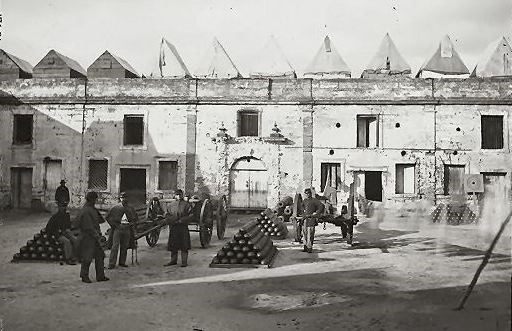|
The origins of the American Civil War are many and complex. In the early years of the 19th century, states’ rights versus central government, differing cultures between Northern and Southern states, misunderstanding and distrust, an unequal system of American tariffs & taxes, slavery and its expansion into the new territories, opposing views of the U.S. Constitution, and the struggle to maintain a balance of political power between Northern and Southern states all were issues that tragically drove the Nation toward separation and ultimately war. Secession and SeizureDespite years of conciliation and compromise, the political situation continued to polarize. The election of Abraham Lincoln to the presidency in 1860 by a majority made up of only Northern electoral votes created an unavoidable split between the states. On December 20, 1860, South Carolina, claiming the right to dissolve its association with the rest of the nation, formally seceded from the Union. Several Southern states soon followed her lead. On January 10, 1861, the state legislature of Florida voted unanimously for secession, making it the third Southern state to dissolve from the Union, joining Mississippi and South Carolina. Under the ConfederacyLike most places throughout the state of Florida, the news of secession was received with celebration and excitement in St. Augustine. Very quickly, however, the reality of war sank in. The United States Navy North Atlantic Blockading Fleet began patrolling Southern coasts, trying to cut off the Confederacy’s commerce with Europe, the only source for most of its needs. Soon, even basic necessities became scarce, and life changed dramatically. The glow of the old Spanish lighthouse and several others farther down the coast were extinguished to prevent navigational aid to the Union Naval blockade that slowly tightened its noose around the Southern coastline and economy. Learn more about the blockade here. 
Union Occupation and Confederate DefeatBy early 1862, Federal forces began to seize a series of poorly defended Southern coastal towns, including St. Augustine. On February 28th, 26 U.S Navy ships sailed from Hilton Head, South Carolina’s Department of the South headquarters to occupy Fernandina, Jacksonville, and St. Augustine. On March 12th, in a small boat flying the white flag of truce, Commander. C. R. P. Rodgers left DuPont’s flagship USS Wabash, anchored off St. Augustine Inlet, to receive the surrender of St. Augustine. Three days prior, the remaining Confederate forces had withdrawn farther south, leaving St. Augustine undefended and open to a peaceful occupation. Rodgers was met by Mayor Christobal Bravo and other town council members. They were informed that he “had a single purpose- to restore the state of affairs which existed before the rebellion.” The city officials were assured they could continue to administer the town as long as Federal authority was recognized. Immediately, the Stars and Stripes were hoisted from Fort Marion. Du Pont wrote to Secretary of the Navy Gideon Wells: “The American flag is flying once more over the old city, raised by the hands of its own people…” 
Throughout the war, nearly 6,000 Federal troops came through St. Augustine. Most were housed at the St. Francis Barracks while small detachments were also housed on the gun deck of Fort Marion in temporary hutments and tents. A typical day for a soldier would have consisted of guard duty at various locations throughout town, military drill on the fields south of the Barracks, working parties, and foraging the local area for food and supplies to add to their issued rations. AftermathAfter the war, President Andrew Johnson initially continued with Lincoln’s gradual reconstruction plan. But under this policy, former Confederate statesman were reelected to seats in Congress and began passing laws negating the gains of the war, such as a series of “Black Codes” limiting the rights of African Americans in the Southern states. Changes had to be made. Republicans gained control of the U.S. Congress in the elections of 1866 and in short time began passing radical legislation. The Southern states were treated as conquered territories and divided into military districts under Army control. The rights of freedmen were broadened, while those of former Confederates were greatly limited. |
Last updated: August 23, 2018
